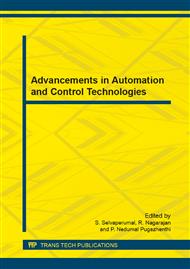[1]
K. Bhattacharya, M. H. J. Bollen and J. E. Daalder Operation of Restructed Power Systems, Kluwer Academic Publishers, (2001).
Google Scholar
[2]
Wood, A.J. and Wollenberg, B.F.: Power Generation, Operation and Control, John Wiley and Sons, New York, (1984).
Google Scholar
[3]
Gary W. Chang , Mohamed Aganagic, James G. Waiht, Jose Medina, Tony Burton, Steve Reeves, Experiences with Mixed Integer Linear Programming Based Approaches on Short Term Hydro Scheduling, IEEE Transactions on Power Systems, (2001), pp.743-749.
DOI: 10.1109/59.962421
Google Scholar
[4]
Ferrero R.W., Rivera J.F., Shahidehpour S.M., A Dynamic Programming Two-Stage algorithm for Long Term Hydro-Thermal Scheduling of Multi Reservoir Systems, IEEE Transaction on Power System, (1998), pp.1534-1540.
DOI: 10.1109/59.736302
Google Scholar
[5]
Ngundam J.M., Kenfack F., Tatietse T.T., Optimal Scheduling of Large Scale Hydro Thermal Power System using the Lagrangian Relaxation Technique, International Journal on Electrical Power & Energy System, (2002), pp.237-245.
DOI: 10.1016/s0142-0615(99)00054-x
Google Scholar
[6]
Richter C.W. Jr. and Sheble G.B. A profit based unit commitment GA for the competitive environment IEEE Transaction on Power Systems, (2000), pp.715-721.
DOI: 10.1109/59.867164
Google Scholar
[7]
M. Basu, "Hopfield neural networks for optimal scheduling of fixed head hydrothermal power systems, Electric Power Systems Research, (2003) pp.11-15.
DOI: 10.1016/s0378-7796(02)00118-9
Google Scholar
[8]
S. Padmini, C. Christober Asir Rajan, and Pallavi Murthy, Application of Improved PSO Technique for Short-Term Hydrothermal Generation scheduling of power system, Lecture notes in Computer Science., Vol. 2, (2011), pp.176-182.
DOI: 10.1007/978-3-642-27172-4_22
Google Scholar
[9]
S. Prabakar Karthikeyan, K. Palanisamy, I. Jacob Raglend and D.P. Kothari, Security Constrained UCP with Operational and Power Flow Constraints, International Journal of Resent Trends in Engineering, Vol. 1, No. 3, (2009).
Google Scholar
[10]
S. Padmini, R. Jegatheesan, Subhransu Sekhar Dash, C. Christober Asir Rajan' Evolutionary programming based Hydrothermal Commitment Scheduling for Maximizing the Profit of GENCO considering the effect of Reserve in a Deregulated Energy Market, International Review of Electrical Engineering, (2013).
Google Scholar
[11]
Nidul Sinha, R. Chakrabarti Fast Evolutionary Programming Technique for Short-term Hydrothermal Scheduling, IEEE Trans. PWRS, Vol. 18, No. 1, (2003), pp.214-219.
DOI: 10.1109/tpwrs.2002.807053
Google Scholar
[12]
Enhancement of Hydroelectric Generation Scheduling using Ant Colony System based Optimization Approaches, IEEE Transactions on Energy Conversion, (2001), pp.296-301.
DOI: 10.1109/60.937211
Google Scholar
[13]
Liao, G.C. Short Term thermal generation scheduling using improved immune algorithm, Electric. Power System. Research, (2006), pp.360-373.
DOI: 10.1016/j.epsr.2005.06.009
Google Scholar


